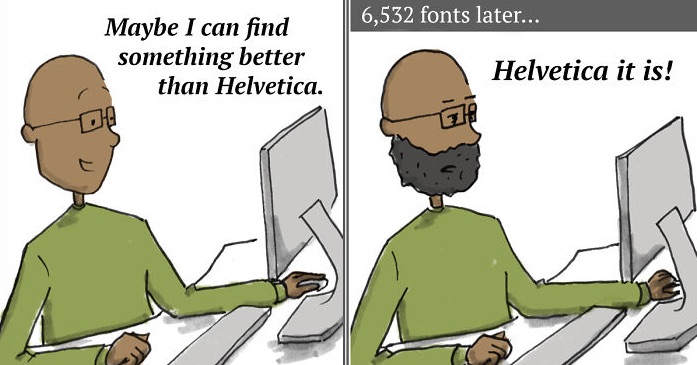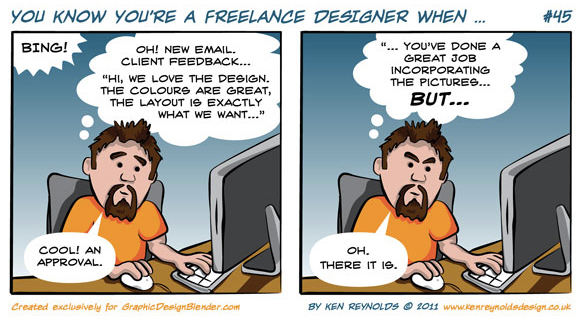How to Deal with Clients That Aren’t Designers (But Think They Are)
Look, you’ve spent years honing your craft, learning the tricks of the trade, and working hard to set yourself apart from the competition and make a name for yourself as a real expert in your field.
That’s why it can be particularly frustrating to encounter a client that doesn’t see you that way – or, at the very least, thinks they can do what you can do without half the training or talent.
Sure, they appreciate your portfolio and they know what you have to offer is probably better than what they can do. Yet whenever you send your designs for approval, they always have something to tweak. There are always one or two things they want done differently.
That’s when you politely remind them that there’s a reason for everything you’ve done, and changing it would significantly impact the work as a whole.
But what happens if they insist that you make changes, even though you know those changes will ruin your work?
Well, there’s good news and bad news…
The Good News: You’re the Expert
There’s a reason they hired you, and it’s because you know what you’re doing. The trick is convincing them that you see a perspective they might have missed.
Be Prepared

Source: BoredPanda
Make sure that every time you present your work, you’re fully prepared. Common issues that come up with design work in particular include logo sizes, choice of fonts (anything but Comic Sans, please), and content location.
The best thing you can do is to have a solid explanation for why you chose the size/font/placement that you did, and include those reasons when you submit your work. Sending a file without context is simply begging for unwanted commentary.
Don’t forget that designs get passed around too, and clients may not always include your explanation when they share your proposals with others. Be ready to rehash your reasoning as many times as possible, if necessary. Yes, it’s annoying, but it may save you from having a major headache later on in the process.
Choose Your Battles

Source: Smashing Magazine
Remember, when it comes to their business, your clients are just as protective of their creative vision as you are of yours. Your clients are not the enemy. They’re coming to you because you know what you’re doing, so you want to make sure you present yourself as an expert without belittling their approach.
If changes they suggest aren’t absolutely vital to your design aesthetics or aren’t time consuming to make, you can let your clients win. If, however, you find yourself fighting the urge to vomit when you think about tweaking your design, stick to your guns.
Act Like An Expert (But Not A Jerk)
Sometimes “sticking to your guns” will mean telling the client that their ideas are terrible, which may or may not go over so well depending on the client. But there are a few ways you can frame the conversation so that you both walk away winners.
#1. Reframe their concerns to solve a problem. Every client has an underlying reason they want a project done a certain way; maybe they have a specific audience or goal in mind. Assure them you really are acting in the best interests. Let them know that you were really listening during their proposal, you’ve done some research of your own, and according to that research, your approach may actually improve their desired results. If you really want to go the extra mile, have some studies on hand that back it up.
#2. Make sure to include them in the process. You’re an expert in your field, but they’re also experts in their respective fields. If they have certain colors they want to use or content they want to include, do your best to incorporate what they want it in ways that work for you too. Again, if something they suggest is just too far out there and you simply can’t make it work with the current project, suggest another project or solution and help them understand why it won’t work with the current design.
#3. Use the right language for the right situation. Telling your clients that they’re terrible people is a lot different than suggesting that a design strategy may not work as well as they’d hoped. But it’s incredibly easy for frustration to turn an innocent suggestion into an actual insult. Remember that words can start wars as easily as they can solve problems, so choose your words carefully. (Mike Michalowicz over at Amex’s OPEN Forum wrote a great article about using the right language with difficult clients.)
The Bad News: The Client Is “Always Right”
Of course, at the end of the day, what really matters is what the client wants. As much as you’re an expert and a highly valuable member of the team, they’re the ones writing the checks, so what they say, goes.
But what happens if you just can’t come to a feasible solution that works for both you and the client? Well, you may either have to do a little conflict resolution, or you may have to straight up dump them as a client.
Handle Conflict Like a Pro

Source: Millo
The absolute best thing you can do is to remain as professional as possible. No matter what, keep your cool.
Let’s say the worst has happened and you’ve done hours of work only to have the client reject everything and ask you to start over. Maybe you’re even willing to do so, but when you tell them how much a new design will cost, they freak out. The last thing you want to do is add fuel to the fire by blaming others or being rude.
Listen to what they have to say, admit any faults from your end, offer any alternative solutions you see, use positive language, and if things get really heated, walk away.
Not only will keeping calm potentially save your relationship with the client (should you choose to continue working with them) but you’ll also save your reputation in the industry over the long haul.
Make Your “Dear John” Sweet But Swift
Of course, having a high level of professionalism on your end doesn’t mean that the client will respond with the same attitude.
Sometimes clients will come to you because you’re just another creative type who can get things done, and not because you specifically have skills they want. If you can’t do what they want, they might throw a fit or - worst case scenario, decide to withhold payment or otherwise make your working relationship a living nightmare.
If things just aren’t working out the way you’d like, you always have the option of walking away. Here’s what to keep in mind while doing so:
#1. Finish any work related to your written contract or verbal agreement. The last thing you want is to get sued by a vindictive client who paid you money to do a project you didn’t finish (at least finish from their perspective). Make sure that you’ve fulfilled any obligations that you signed up for, or that you have an escape clause in the contract that you signed before you start working with them (an ounce of prevention…).
#2. Set a firm “leave by” date and stick to it. Let your clients know that you’ll be moving on and that they can expect to receive any remaining files from you by a certain date.
#3. Try not to burn a bridge (if at all possible). If you can, include a few positive statements in your “Dear John” email about why you liked working with them and let them know that you’re available for other work in the future (if you’re open to that, obviously). Remember that referrals are a great source of business, so if you can salvage the relationship professionally, do so.
Final Thoughts
Dealing with clients can be tricky, especially when they feel like they can do your job as well as you can. But remember that you’re the expert and you know what you’re doing, and they’re coming to you for your design prowess.
If the time comes where you need to convince a client that your way is best, remember to backup any suggestions with resources, use positive language, offer alternative solutions, and try to incorporate their ideas as much as possible (without sacrificing your time and talent, of course).
If things just aren’t working out and you simply need to move on, be professional, be quick, and don’t burn a bridge unless absolutely necessary.